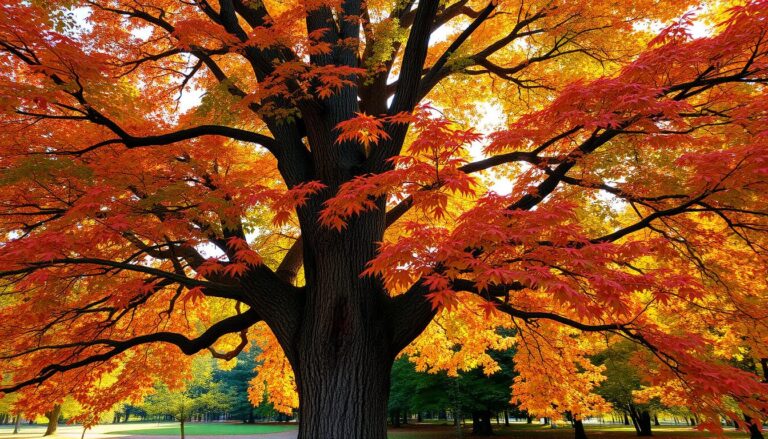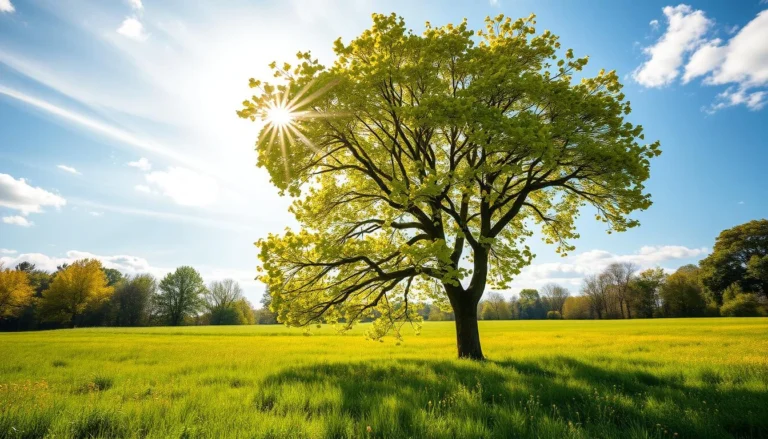“Cypress Tree: A Deep Dive into Their History, Benefits, and Landscaping Uses”
Imagine a towering, evergreen sentinel that has weathered the test of time. Its branches reach skyward like arms embracing the natural world. These captivating trees, known as cypress, are more than just ornamental plants. They are living testaments to the enduring beauty and resilience of our planet.
But have you ever wondered about the rich history, versatile benefits, and diverse landscape applications of these evergreen conifers? Prepare to embark on a journey that will unravel the secrets of the cypress tree. Discover how these majestic wonders can transform your outdoor spaces.
Table of Contents

Key Takeaways
- Cypress trees are evergreen conifers that belong to the Cupressaceae family, with over 600 species found across the globe.
- These trees have a long history, symbolizing resilience, endurance, and a deep connection to the natural world.
- Cypress trees offer a diverse range of varieties, from the towering Italian cypress to the adaptable Leyland cypress, suited to various climates and landscape applications.
- Cypress trees provide valuable benefits, including air purification, temperature regulation, and wildlife habitat.
- Incorporating cypress trees into your landscape can enhance the overall aesthetic and create a serene, natural oasis.
The Evergreen Marvels: A Resilient Legacy
Evergreen trees, like cypress, have amazed people for centuries. They symbolize strength, renewal, and spiritual protection. In winter, when many plants lose their leaves, evergreens stay green. This shows nature’s strength.
In many cultures, evergreen boughs in homes were seen as symbols of hope and protection. They were thought to keep evil away.
Evergreens’ Symbolic Significance and Traditional Practices
Evergreen trees mean a lot to different cultures. They stand for eternal life, fertility, and the cycle of life. Their green leaves in winter are key in holiday traditions, from ancient Saturnalia to today’s Christmas trees.
These trees were seen as protectors against evil. They were believed to bring good luck to homes that welcomed them.
The Magical Medicine of Evergreen Resins
Evergreen trees are also known for their healing properties. Their oils and resins have been used for thousands of years in medicine. They help with breathing, boost the immune system, and improve mood.
The scent of evergreen trees is used in many ways. It’s in incense, essential oils, balms, and tinctures. This scent is calming and healing.
| Evergreen Tree | Traditional Medicinal Uses |
|---|---|
| Cypress | Respiratory support, antiseptic, anti-inflammatory |
| Pine | Immune system support, expectorant, antioxidant |
| Juniper | Detoxification, diuretic, digestive aid |
“The evergreen’s ability to thrive in the harshest of conditions is a testament to its resilience, making it a symbol of hope and endurance for many.”
Introducing the Cypress Family
The cypress family, Cupressaceae, includes many evergreen conifers. They live in different climates and places. This family has about 130 species, with the Cupressoideae being well-known.
The bald cypress (Taxodium distichum) is a standout in the Cupressaceae family. It’s a deciduous conifer from the southeastern United States. It’s known for its tall height, long life, and ability to grow in many soils.
The Bald Cypress: A Towering Testimony to Endurance
The bald cypress, also called the swamp cypress, is special in the Cupressaceae family. It loses its needles in the fall, showing its unique “knees” that stick out of the water. These features help it live in wet places, like marshes and swamps.
From Ancient Forests to Underwater Wonders
The Cupressaceae family’s strength is seen in ancient cypress forests found underwater. These underwater cypress groves, in places like the Black Sea and Gulf of Mexico, show how these trees have lasted for thousands of years.
“The cypresses, which are so characteristic a feature of Italian landscapes, are among the oldest of European trees, and their presence links the modern scenery with that of classical antiquity.”
Exploring the Cupressaceae family reveals a world of history, resilience, and beauty. It shows the deep bond between these evergreen giants and the landscapes they’ve touched for centuries.
Cypress Tree: An Aromatic Journey
Explore the world of cypress, pine, and other evergreen wonders. These trees are not just beautiful but also full of natural remedies. Discover the calming effect of cedar, the health benefits of pine, and more.
Cedar: Grounding Presence and Natural Protection
Cedar is known for its earthy smell and calming effect. Its essential oil is great for cleaning and spiritual practices. Use cedarwood in diffusers, on your skin, or to keep moths away.
Pine: The Respiratory System’s Ally
The pine tree is tall and has a strong scent. It’s full of terpenes that help your breathing. Use pine oil in diffusers or in your skincare for better health.
These evergreen trees offer powerful aromatic medicine. They can improve our well-being. Start this journey with cypress, pine, and cedar for a better life.
Fir and Juniper: Woodland Warriors
Beyond the iconic cypress and cedar, fir and juniper are also key players. These trees offer many benefits for our health and our connection to nature.
Fir: Resilience and Relief
Fir trees belong to the Pinaceae family. They are known for their anti-inflammatory, antioxidant, and expectorant properties. This makes them great for our respiratory health and immune system.
The douglas-fir is especially known for its toughness. It can grow well even in tough environments.
Juniper: Cleansing and Purifying
Juniper is part of the Cupressaceae family. It’s famous for its ability to cleanse and purify. The berries and wood of the juniper tree have been used for centuries for their antimicrobial and detoxifying effects.
By embracing the wisdom of fir and juniper, we can reconnect with nature’s healing power. This can improve our breathing, immune strength, and overall health.
“The fir tree, tall and slender, stands as a symbol of strength and endurance, while the juniper, with its cleansing aroma, reminds us of the importance of purification and renewal.”
Landscaping with the Cypress Tree
Cypress trees come in many shapes and sizes, making them great for any landscape. They range from tall Italian cypress to small Leyland cypress. These evergreens fit well in both formal hedges and natural groupings.
Cypress trees grow well in many soils and climates. They keep their leaves all year and have striking shapes. This makes them perfect for making outdoor spaces look better and work better.
Looking to add drama or privacy? Cypress trees can do it all. Choose the right cypress tree for your garden design to create a beautiful space.
- Bald cypress trees can live for hundreds of years and grow up to 150 feet in height.
- Pond cypress trees generally do not reach the massive size of bald cypress and can still grow up to 80 feet tall.
- Pond cypress are relatively maintenance-free and require only occasional pruning to remove dead limbs.
Cypress trees are essential for anyone who loves landscaping. They make any outdoor space look amazing and sustainable.
“Cypress trees are the quintessential evergreen, adding a timeless elegance to any garden design.”
Cypress Tree: A Deep-Rooted Connection
Cypress trees have a deep cultural and spiritual meaning worldwide. They are seen as symbols of long life, strength, and mourning. They show the cycle of life, death, and rebirth. From ancient Egypt to Native American cultures, the cypress is a key part of human history.
The cultural significance of the cypress tree comes from its ability to last long. These tall trees have been used in buildings and sacred places for ages. They stand as symbols of nature’s power. In many cultures, the cypress is linked to death and mourning, showing the eternal cycle of life.
The spiritual symbolism of the cypress tree is also deep. In ancient Greece, it was linked to Hades, the god of the underworld. This shows its role in connecting the physical and spiritual worlds. In Native American cultures of the southeast, the cypress was valued for its healing properties and spiritual connection. Its resin was used in sacred rituals.
Learning about the cypress tree’s rich meaning helps us appreciate these plants more. They symbolize endurance, connect us to nature, and embody spiritual traditions. The cypress tree continues to inspire us, inviting us to explore the significance of evergreen trees in our lives.

Sustainably Harvesting Evergreen Wisdom
The need for natural remedies and wellness products is growing fast. It’s important to harvest evergreen trees in a way that’s good for the planet. These trees have many valuable compounds that can be taken from them safely.
Using the right methods in forestry helps keep these trees healthy for a long time. This way, we can use their benefits without harming the environment. It lets us enjoy the healing powers of cypress and other evergreen trees.
Harvesting evergreen trees the right way means taking care of the ecosystem. Here are some important steps for doing it right:
- Selective and controlled pruning: Trim branches carefully to keep the tree healthy and prevent too much taking.
- Resin tapping: Take resins and saps without hurting the tree, so it can keep making more.
- Needle and bark harvesting: Take needles, bark, and other parts without harming the tree’s structure.
- Seed and cone collection: Collect seeds and cones carefully to help the species grow and stay diverse.
By following these steps, we can keep getting the good stuff from evergreen trees. We also help these amazing trees stay strong and healthy.
| Evergreen Tree | Medicinal Compounds | Aromatic Extracts |
|---|---|---|
| Cypress | Terpenes, flavonoids, lignans | Cedarwood, cypress, and pinene-rich essential oils |
| Pine | Tannins, phenols, triterpenoids | Turpentine, pine needle, and pine resin oils |
| Fir | Diterpenes, sesquiterpenes, polyphenols | Balsam fir and fir needle essential oils |
| Juniper | Terpenes, flavonoids, organic acids | Juniper berry and wood essential oils |
By choosing to harvest evergreen trees the right way, we help them last for a long time. This way, we can keep getting the good stuff from them. It’s a way to take care of the environment and use the wisdom of these trees.
“Sustainable harvesting is not just about meeting the demands of the present, but about preserving the health and abundance of our evergreen forests for generations to come.”
Embrace the Evergreen Essence
The scents of evergreen trees like cypress, cedar, and pine are amazing. They can help your health and mood, especially in winter. By using these scents in recipes, you can boost your breathing, immune system, and mood. It’s a way to connect with nature’s power and feel its healing energy.
Aromatic Recipes for Winter Wellness
Try these evergreen-inspired recipes to boost your winter health:
- Cypress and Rosemary Chest Rub: Mix cypress oil with rosemary for a chest rub. It helps with breathing and congestion.
- Cedar and Frankincense Meditation Incense: Use cedar and frankincense for a calming incense. It helps you relax and think deeply.
- Pine and Eucalyptus Steam Inhalation: Breathe in pine and eucalyptus vapors. They clear your airways and support your breathing.
“Embracing the evergreen essence allows us to connect with the resilience and rejuvenating energy of these botanical wonders, fostering a deeper appreciation for the natural world and its ability to nourish and heal.”
Discover the benefits of evergreen aromatherapy, winter wellness, and herbal remedies. They can improve your self-care and balance in the cold months. Use essential oils and enjoy the evergreen essence for a holistic health approach.

Conclusion
The cypress tree has amazed people for centuries. It’s not just a tree; it’s full of meaning and uses. From its role in cultures to its uses in landscaping and medicine, it’s truly special.
By learning about cypress trees, we grow to love nature more. We see how it can help and heal us. This knowledge helps us care for our planet better.
Embracing the cypress tree’s spirit can make us healthier and more connected to nature. It shows us the strength and beauty of the natural world. It teaches us important lessons for our own growth and for keeping our planet safe.
People are drawn to the cypress tree for many reasons. Its healing powers, its beauty in gardens, and its deep meaning are just a few. By valuing cypress trees and their family, we help create a better world. A world where humans and nature live in harmony.
FAQ
What is a cypress tree?
Cypress trees are evergreen conifers in the Cupressaceae family. They have over 600 species worldwide. These trees symbolize resilience and a deep connection to nature.
What are the different types of cypress trees?
The cypress family includes many types. You have the tall Italian cypress and the adaptable Leyland cypress. There’s also the Monterey cypress and the Arizona cypress. Plus, the bald cypress, Portuguese cypress, and swamp cypress.
What are the cultural and spiritual significances of cypress trees?
Cypress trees are deeply valued worldwide. They symbolize longevity and endurance. They also represent the cycle of life, death, and rebirth.
How can cypress trees be used in landscaping?
Cypress trees are great for landscaping. They come in various shapes and sizes. They can be used for hedges, screens, or natural groupings.
What are the medicinal and aromatic properties of cypress trees?
Cypress trees have aromatic compounds. These are valued for their health benefits. They support the respiratory system, immune function, and emotional well-being.
How can evergreen trees be sustainably harvested?
Sustainable forestry practices help preserve evergreen trees. This way, we can use their benefits responsibly. It ensures their long-term health and abundance.
How can the evergreen essence be incorporated into daily life?
We can embrace the evergreen essence in our daily lives. This includes the scents of cypress, cedar, and pine. It connects us to nature’s resilience and healing power.







